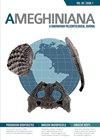Exploring the First Appearance of the Main Derived Conifer Families of Gondwana: Evidence Provided by the Triassic Woods from Argentina
IF 1.5
4区 地球科学
Q3 PALEONTOLOGY
引用次数: 1
Abstract
Abstract. The relevance of improving the knowledge on Triassic conifers resides in that the modern clades originated during the Late Triassic–Early Jurassic. More than 30 conifer-like fossil woods are known from the Triassic strata of Argentina. Whereas some have not been linked to any family, others have been related to the “Protopinaceae”, Taxaceae, Podocarpaceae, Araucariaceae, Cupressaceae, or Hirmeriellaceae (=Cheirolepidiaceae). The diversity of woods with anatomy close to derived conifers contrasts with the scarce Triassic record of leaves and micro and megasporangiate cones, which could be explained by a combination of taphonomic and evolutionary causes. In order to provide information to resolve this controversy, the anatomy and systematic affinities of Triassic permineralized conifer-like trunks and woods described to date for Argentina were reassessed. As a result of this review, it emerged that the woods previously assigned to Podocarpaceae and Taxaceae do not have enough preserved characters to support such assignment, or they have characters that are homoplasic in the context of Mesozoic gymnosperms and therefore their affinity is ambiguous. On the contrary, the reevaluation of the woods related to the Araucariaceae, Cupressaceae and Hirmeriellaceae (=Cheirolepidiaceae) allows us to support their affinity with these families. Resumen. La importancia en avanzar en el conocimiento de las coníferas triásicas radica en que durante el lapso Triásico Tardío–Jurásico Temprano se produce el origen de los clados modernos. Para el Triásico argentino se conocen más de 30 leños fósiles comparables a las coníferas. Mientras que algunos no se han vinculado con alguna familia, otros han sido relacionados con las “Protopinaceae”, Taxaceae, Podocarpaceae, Araucariaceae, Cupressaceae o Hirmeriellaceae (=Cheirolepidiaceae). La diversidad de leños con morfología afín a las coníferas derivadas contrasta con el escaso registro triásico de hojas y conos micro y megasporangiados, lo que podría deberse a una combinación de causas tafonómicas y evolutivas. Con el objetivo de aportar información que ayude a resolver esta controversia, se revisó la anatomía y la afinidad sistemática de los leños permineralizados de edad triásica descriptos hasta la actualidad para la Argentina. Como resultado de esta revisión, se determinó que los leños previamente asignados a Podocarpaceae y Taxaceae no poseen suficientes caracteres preservados para sostener tal asignación, o presentan caracteres que resultan homoplásicos en el contexto de las gimnospermas mesozoicas y por lo tanto su afinidad es ambigua. Por el contrario, la reevaluación de los leños relacionados a las Araucariaceae, Cupressaceae y Hirmeriellaceae (=Cheirolepidiaceae) permite sostener su afinidad con dichas familias.冈瓦纳大陆主要针叶树科首次出现的探索——来自阿根廷三叠纪森林的证据
摘要。提高对三叠纪针叶树知识的相关性在于,现代氏族起源于晚三叠世-早侏罗世。阿根廷三叠纪地层已知30多个针叶树样化石森林。虽然有些与任何家族都没有联系,但另一些与“原松科”、红豆杉科、鬼针草科、南洋杉科、柏科或喜树科(=Cheirolepidiaceae)有关。解剖接近衍生针叶树的森林的多样性与叶和微孢子囊和大孢子囊圆锥的严格三叠纪记录形成鲜明对比,这可以用解剖和进化原因的结合来解释。为了提供解决这一争议的信息,重新评估了迄今为止为阿根廷描述的三叠纪永久化针叶树状树干和森林的解剖和系统归属。由于这一审查,出现了以前分配给鬼臼科和红豆杉科的森林没有足够的保存特征来支持这种分配,或者它们的特征在中生代裸子植物的背景下是同源的,因此它们的亲缘关系模棱两可。相反,对与南洋杉科、柏科和喜树科(=Cheirolepidiacea)有关的森林的重新评估使我们能够支持他们与这些家庭的亲和力。总结。提高对三叠纪针叶树的认识的重要性在于,在晚三叠世-早侏罗世时期,现代分支的起源发生了。对于阿根廷三叠纪,已知30多个与针叶树相当的化石记录。虽然有些与某一科没有联系,但另一些与“原松科”、红豆杉科、鬼针草科、南洋杉科、柏科或喜树科(=Cheirolepidiaceae)有关。形态与衍生针叶树相似的木材的多样性与三叠纪微孢子和大孢子叶和球果的记录很少形成鲜明对比,这可能是由于塔音和进化原因的结合。为了提供有助于解决这一争端的信息,对阿根廷迄今为止描述的三叠纪时代永磁化木柴的解剖结构和系统亲和力进行了审查。经过这一审查,发现以前分配给鬼臼科和红豆杉科的木材没有足够的保存特征来维持这种分配,或者它们的特征在中生代裸子植物的背景下是同源的,因此它们的亲和力是模棱两可的。相反,重新评估与南洋杉科、柏科和喜树科(=Cheirolepidiaceae)有关的木材可以维持其与这些家庭的亲和力。
本文章由计算机程序翻译,如有差异,请以英文原文为准。
求助全文
约1分钟内获得全文
求助全文
来源期刊

Ameghiniana
地学-古生物学
CiteScore
2.50
自引率
10.00%
发文量
21
期刊介绍:
Ameghiniana is a bimonthly journal that publishes original contributions on all disciplines related to paleontology, with a special focus on the paleontology of Gondwana and the biotic history of the southern hemisphere. Published yearly since 1957, it has undoubtedly become the main palaeontological publication from Latin America. Ameghiniana has recently broadened its editorial board, reorganized its production process, and increased to a bimonthly frequency, which resulted in a significant decrease in the turn around time.
 求助内容:
求助内容: 应助结果提醒方式:
应助结果提醒方式:


